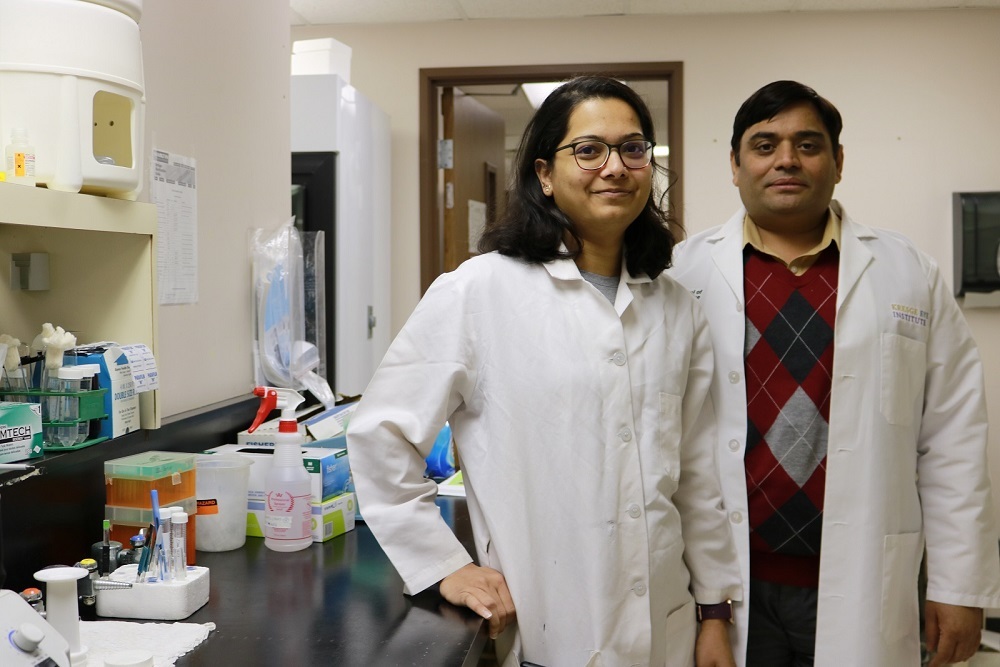Wayne State University School of Medicine issued the following announcement on March 09.
Sneha Singh, Ph.D., is a postdoctoral fellow in the laboratory of Ashok Kumar, Ph.D., right, who is an Associate Professor of Ophthalmology, Visual and Anatomical Sciences.
Researchers in the Department of Ophthalmology, Visual and Anatomical Sciences at Wayne State University School of Medicine have revealed a regulator of energy metabolism as a potential target in restricting Zika virus replication.
Viruses are known to disturb host cellular metabolism to enable their replication and spread. However, little is known about the interactions between the Zika virus, or ZIKV, infection and host metabolism.
The mosquito-transmitted virus emerged as a public health threat a few years ago, causing the largest outbreaks in 2015 and 2016 in Brazil and globally. ZIKV infection in pregnant women caused infants born with microcephaly and abnormalities in other organs, including the eye. In the eyes of newborn infants, ZIKV caused ocular anomalies such as retinal lesions, chorioretinal atrophy, mottling of the retinal pigment epithelium, optic neuritis and hemorrhagic retinopathy.
Because of these ocular abnormalities, in 2016 Associate Professor Ashok Kumar, Ph.D., initiated a study to determine the pathobiology of ZIKV in the eye. His laboratory has developed several experimental models and published extensively in this area.
Sneha Singh, Ph.D., a postdoctoral fellow in the laboratory of Dr. Kumar, is the lead author on one of the latest studies, “AMP-Activated Protein Kinase Restricts Zika Virus Replication in Endothelial Cells by Potentiating Innate Antiviral Responses and Inhibiting Glycolysis,” published in the Journal of Immunology, a peer-reviewed journal of the American Association of Immunology.
“Although the incidence of ZIKV has gone down, the threat is always there. One of the prime examples is the recent outbreak of coronavirus, which caused similar outbreaks in 2003 with SARS (Severe Acute Respiratory Syndrome) and 2012 with MERS (Middle East Respiratory Syndrome). Basically, it’s the same virus, but over the years it has evolved and mutated by passing through various hosts,” Dr. Kumar said. “Honestly, another newly-evolved ZIKV could be just around the corner. We need continuous monitoring of emerging and remerging viruses. Moreover, coronavirus causes mortality, ZIKV does not, which makes it more difficult to get noticed and diagnosed routinely. For the same reason, my laboratory has continued efforts to research in this area.”
The eye is protected from invading pathogens by a blood-retinal barrier composed of unique cell types called endothelial and retinal pigment epithelial cells. “In our previous studies, we showed that ZIKV infects these cells, leading to viral entry in the eye. Once infected, how the virus hijacks host cellular machinery to promote its replication and spread is not clearly understood. We hypothesized that ZIKV modulates cellular metabolism, and discovered a new role of AMPK, a master regulator of energy metabolism,” Dr. Kumar said.
They found that ZIKV increased glycolysis in infected cells and downregulated AMPK activity. Although glycolysis is essential for host cells to generate energy, it also provides building blocks for virus replication. Because AMPK inhibits cellular glycolytic activity, ZIKV was found to inactivate this protein to keep the glycolysis switch on. Activation of AMPK using specific drugs resulted in reduced viral replication and robust induction of innate antiviral responses, restricting ZIKV replication.
“Drugs targeting AMPK activation can reduce ocular inflammation and pathology, reducing the disease burden.” Dr. Singh said.
The researchers are now trying to investigate the detailed mechanism of ZIKV-induced alteration of energy metabolism and the key target molecules to identify potential candidates for therapeutic intervention.
The work was supported by the National Institutes of Health (R21AI135583, R01EY026964 and R01EY027381).Another study conducted at the University of California at Los Angeles in collaboration with Dr. Kumar showed that ZIKV dysregulates Hippo signaling, a key pathway involved in organ size development. AMPK was found to regulate Hippo signaling. The paper was published in the American Journal of Pathology.
“It was interesting to see how these two independent studies converge on AMPK,” Dr. Kumar said. “We are currently investigating the crosstalk between AMPK and Hippo signaling in regulating the antiviral innate response to ZIKV. Our preparedness against the viral diseases, whether its ZIKV or Coronavirus, will defend us from future outbreaks and epidemics as the virus is capable of evolving and causing unpredicted havoc to mankind evident with the ongoing novel-coronavirus outbreaks worldwide. Therefore, we do not need to panic, but stay alarmed and take all the necessary precautions to contain the disease and pursue active research to find alternative therapeutic targets for new drug development.”
Original source can be found here.






 Alerts Sign-up
Alerts Sign-up